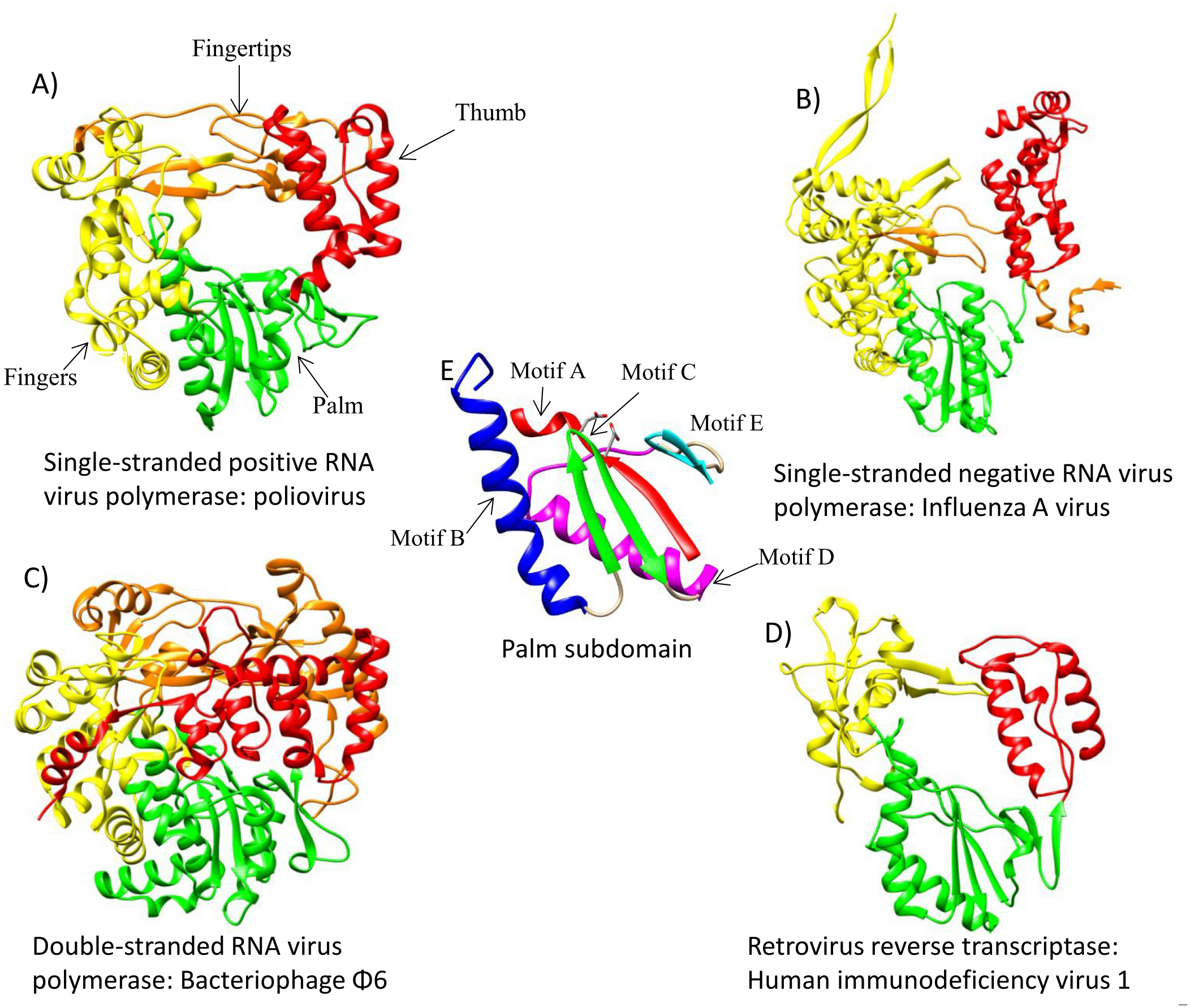|
Picornaviruses
Picornaviruses are a group of related nonenveloped RNA viruses which infect vertebrates including fish, mammals, and birds. They are viruses that represent a large family of small, positive-sense, single-stranded RNA viruses with a 30 nm icosahedral capsid. The viruses in this family can cause a range of diseases including the common cold, poliomyelitis, meningitis, hepatitis, and paralysis. Picornaviruses constitute the family ''Picornaviridae'', order '' Picornavirales'', and realm ''Riboviria''. There are 159 species in this family, assigned to 68 genera, most of which belong to 5 subfamilies. Notable examples are genera ''Enterovirus'' (including ''Rhinovirus'' and ''Poliovirus''), '' Aphthovirus'', '' Cardiovirus'', and '' Hepatovirus''. Etymology The name "picornavirus" has a dual etymology. Firstly, the name derives from ''picorna''- which is an acronym for "''p''oliovirus, ''i''nsensitivity to ether, ''c''oxsackievirus, ''o''rphan virus, ''r''hinovirus, and ... [...More Info...] [...Related Items...] OR: [Wikipedia] [Google] [Baidu] [Amazon] |
Rhinovirus
The rhinovirus (from the "nose", , romanized: "of the nose", and the ) is a Positive-sense single stranded RNA virus, positive-sense, single-stranded RNA virus belonging to the genus ''Enterovirus'' in the family ''Picornaviridae''. Rhinovirus is the most common viral infectious agent in humans and is the predominant cause of the common cold. The three species of rhinovirus (A, B, and C) include at least 165 recognized types that differ according to their surface antigens or genetics. They are among the smallest viruses, with diameters of about 30 nanometers. By comparison, other viruses, such as smallpox and vaccinia, are around ten times larger at about 300 nanometers, while Orthomyxoviridae, influenza viruses are around 80–120 nm. Rhinoviruses are transmitted through aerosols, respiratory droplets, fomites, and direct person-to-person contact. They primarily infect nasal epithelial cells in the airway and cause mild symptoms such as sore throat, cough, and nasal con ... [...More Info...] [...Related Items...] OR: [Wikipedia] [Google] [Baidu] [Amazon] |
RNA Virus
An RNA virus is a virus characterized by a ribonucleic acid (RNA) based genome. The genome can be single-stranded RNA (ssRNA) or double-stranded (Double-stranded RNA, dsRNA). Notable human diseases caused by RNA viruses include influenza, SARS, MERS, COVID-19, Dengue virus, hepatitis C, hepatitis E, West Nile fever, Ebola virus disease, rabies, polio, mumps, and measles. All known RNA viruses, that is viruses that use a homologous RNA-dependent polymerase for replication, are categorized by the International Committee on Taxonomy of Viruses (ICTV) into the realm ''Riboviria''. This includes RNA viruses belonging to ''Group III'', ''Group IV'' or ''Group V'' of the Virus classification#Baltimore classification, Baltimore classification system as well as ''Group VI. Group VI'' viruses are retroviruses, viruses with RNA genetic material that use DNA intermediates in their Viral life cycle, life cycle including HIV-1 and HIV-2 which cause AIDS. The majority of such RNA viruses fall ... [...More Info...] [...Related Items...] OR: [Wikipedia] [Google] [Baidu] [Amazon] |
Positive-sense Single-stranded RNA Virus
Positive-strand RNA viruses (+ssRNA viruses) are a group of related viruses that have positive-sense, single-stranded genomes made of ribonucleic acid. The positive-sense genome can act as messenger RNA (mRNA) and can be directly translated into viral proteins by the host cell's ribosomes. Positive-strand RNA viruses encode an RNA-dependent RNA polymerase (RdRp) which is used during replication of the genome to synthesize a negative-sense antigenome that is then used as a template to create a new positive-sense viral genome. Positive-strand RNA viruses are divided between the phyla '' Kitrinoviricota'', '' Lenarviricota'', and '' Pisuviricota'' (specifically classes '' Pisoniviricetes'' and '' Stelpavirictes'') all of which are in the kingdom '' Orthornavirae'' and realm ''Riboviria''. They are monophyletic and descended from a common RNA virus ancestor. In the Baltimore classification system, +ssRNA viruses belong to Group IV. Positive-sense RNA viruses include patho ... [...More Info...] [...Related Items...] OR: [Wikipedia] [Google] [Baidu] [Amazon] |
Electronmicrograph
A micrograph is an image, captured photographically or digitally, taken through a microscope or similar device to show a magnified image of an object. This is opposed to a macrograph or photomacrograph, an image which is also taken on a microscope but is only slightly magnified, usually less than 10 times. Micrography is the practice or art of using microscopes to make photographs. A photographic micrograph is a photomicrograph, and one taken with an electron microscope is an electron micrograph. A micrograph contains extensive details of microstructure. A wealth of information can be obtained from a simple micrograph like behavior of the material under different conditions, the phases found in the system, failure analysis, grain size estimation, elemental analysis and so on. Micrographs are widely used in all fields of microscopy. Types Photomicrograph A light micrograph or photomicrograph is a micrograph prepared using an optical microscope, a process referred to as ''ph ... [...More Info...] [...Related Items...] OR: [Wikipedia] [Google] [Baidu] [Amazon] |
Poliovirus
Poliovirus, the causative agent of polio (also known as poliomyelitis), is a serotype of the species '' Enterovirus C'', in the family of '' Picornaviridae''. There are three poliovirus serotypes, numbered 1, 2, and 3. Poliovirus is composed of an RNA genome and a protein capsid. The genome is a single-stranded positive-sense RNA (+ssRNA) genome that is about 7500 nucleotides long. The viral particle is about 30 nm in diameter with icosahedral symmetry. Because of its short genome and its simple composition—only a strand of RNA and a nonenveloped icosahedral protein coat encapsulating it—poliovirus is widely regarded as the simplest significant virus. Poliovirus is one of the most well-characterized viruses, and has become a useful model system for understanding the biology of RNA viruses. Replication cycle Poliovirus infects human cells by binding to an immunoglobulin-like receptor, CD155 (also known as the poliovirus receptor or PVR) on the cell surface. Inte ... [...More Info...] [...Related Items...] OR: [Wikipedia] [Google] [Baidu] [Amazon] |
Picornavirales
''Picornavirales'' is an order of viruses with vertebrate, invertebrate, protist and plant hosts. The name has a dual etymology. First, ''picorna-'' is an acronym for poliovirus, insensitivity to ether, coxsackievirus, orphan virus, rhinovirus, and ribonucleic acid. Secondly, pico-, meaning extremely small, combines with RNA to describe these very small RNA viruses. The order comprises viruses that historically are referred to as picorna-like viruses. Characteristics The families within this order share a number of common features: * The virions are non- enveloped, icosahedral, and about 30 nanometers in diameter. * The capsid has a "pseudo T=3" structure, and is composed of 60 protomers each made of three similar-sized but nonidentical beta barrels. * The genome is made of one or a few single-stranded RNA(s) serving directly as mRNA, without overlapping open reading frames. * The genome has a small protein, VPg, covalently attached to its 5' end, and usually a poly-adeny ... [...More Info...] [...Related Items...] OR: [Wikipedia] [Google] [Baidu] [Amazon] |
Riboviria
''Riboviria'' is a Realm (virology), realm of viruses that includes all viruses that use a homologous RNA-dependent polymerase for replication. It includes RNA viruses that Genetic code, encode an RNA-dependent RNA polymerase, as well as Pararnavirae, reverse-transcribing viruses (with either RNA or DNA genomes) that encode an Reverse transcriptase, RNA-dependent DNA polymerase. RNA-dependent RNA polymerase (RdRp), also called RNA replicase, produces RNA (ribonucleic acid) from RNA. RNA-dependent DNA polymerase (RdDp), also called reverse transcriptase (RT), produces DNA (deoxyribonucleic acid) from RNA. These enzymes are essential for Viral replication, replicating the viral genome and Transcription (biology), transcribing viral genes into messenger RNA (mRNA) for Translation (biology), translation of viral proteins. ''Riboviria'' was established in 2018 to accommodate all RdRp-encoding RNA viruses and was expanded a year later to also include RdDp-encoding viruses. These two grou ... [...More Info...] [...Related Items...] OR: [Wikipedia] [Google] [Baidu] [Amazon] |
Enterovirus
''Enterovirus'' is a genus of positive-sense single-stranded RNA viruses associated with several human and mammalian diseases. Enteroviruses are named by their transmission-route through the intestine ('enteric' meaning intestinal). Serologic studies have distinguished 71 human enterovirus serotypes on the basis of antibody neutralization tests. Additional antigenic variants have been defined within several of the serotypes on the basis of reduced or nonreciprocal cross-neutralization between variant strains. On the basis of their pathogenesis in humans and animals, the enteroviruses were originally classified into four groups, polioviruses, Coxsackie A viruses (CA), Coxsackie B viruses (CB), and echoviruses, but it was quickly realized that there were significant overlaps in the biological properties of viruses in the different groups. Enteroviruses isolated more recently are named with a system of consecutive numbers: EV-D68, EV-B69, EV-D70, EV-A71, etc., where genotyping ... [...More Info...] [...Related Items...] OR: [Wikipedia] [Google] [Baidu] [Amazon] |
Cardiovirus
Cardiovirus are a group of viruses within order ''Picornavirales'', family ''Picornaviridae''. Vertebrates serve as natural hosts for these viruses. Taxonomy The genus contains the following species: * ''Cardiovirus dhusarah'' (Cardiovirus F) * ''Cardiovirus ranori'' (Cardiovirus C) * ''Cardiovirus rudhira'' (Cardiovirus E) * ''Cardiovirus rueckerti'' (Cardiovirus A), Encephalomyocarditis virus * ''Cardiovirus saffoldi'' (Cardiovirus D), Saffold virus * ''Cardiovirus theileri'' (Cardiovirus B), which contains Theiler's murine encephalomyelitis virus Structure Cardioviruses are single-stranded RNA, non-enveloped viruses with icosahedral or spherical geometries, and a T=pseudo3 icosahedral capsid protein geometry. The diameter is around 30 nm. Genomes are linear and non-segmented, around 7.8 kb in length. The T=pseudo3 icosahedral capsid of Cadiovirus is made of 60 protomers, each of which contains 4 polypeptides: VP1, VP2, VP3, and VP4. Inside the capsid of the virus th ... [...More Info...] [...Related Items...] OR: [Wikipedia] [Google] [Baidu] [Amazon] |
Aphthovirus
''Aphthovirus'' (from the Greek , , 'vesicles in the mouth') is a viral genus of the family ''Picornaviridae''. Aphthoviruses infect split-hooved animals, and include the causative agent of foot-and-mouth disease, foot-and-mouth disease virus (FMDV). There are seven FMDV serotypes: A, O, C, SAT 1, SAT 2, SAT 3 and Asia 1, and four non-FMDV serotypes belonging to three additional species Bovine rhinitis A virus (BRAV), Bovine rhinitis B virus (BRBV) and Equine rhinitis A virus (ERAV). Taxonomy The genus contains the following species, listed by scientific name: * ''Aphthovirus bogeli'', Bovine rhinitis A virus * ''Aphthovirus burrowsi'', Equine rhinitis A virus * ''Aphthovirus reedi'', Bovine rhinitis B virus * ''Aphthovirus vesiculae'', Foot-and-mouth disease virus Structure Aphthoviruses are non-enveloped and have an icosahedral capsid with a diameter of around 27 to 30 nm. The assembled viral capsid contains a single copy of the RNA genome and 60 copies of ... [...More Info...] [...Related Items...] OR: [Wikipedia] [Google] [Baidu] [Amazon] |
Paralysis
Paralysis (: paralyses; also known as plegia) is a loss of Motor skill, motor function in one or more Skeletal muscle, muscles. Paralysis can also be accompanied by a loss of feeling (sensory loss) in the affected area if there is sensory damage. In the United States, roughly 1 in 50 people have been diagnosed with some form of permanent or transient paralysis. The word "paralysis" derives from the Greek language, Greek παράλυσις, meaning "disabling of the nerves" from παρά (''para'') meaning "beside, by" and λύσις (''lysis'') meaning "making loose". A paralysis accompanied by involuntary tremors is usually called "palsy". Causes Paralysis is most often caused by damage in the nervous system, especially the spinal cord. Other major causes are stroke, Physical trauma, trauma with nerve injury, poliomyelitis, cerebral palsy, peripheral neuropathy, Parkinson's disease, ALS, botulism, spina bifida, multiple sclerosis and Guillain–Barré syndrome. Incidents th ... [...More Info...] [...Related Items...] OR: [Wikipedia] [Google] [Baidu] [Amazon] |








